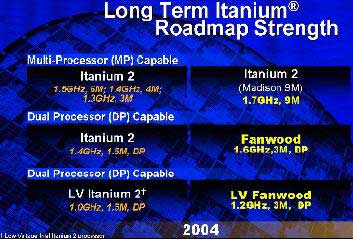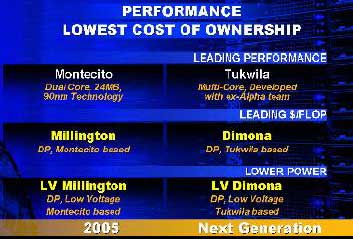
Original Link: https://www.anandtech.com/show/1245
Intel Developer Forum Spring 2004 - Day 2: Roadmap Updates
by Derek Wilson on February 19, 2004 12:47 PM EST- Posted in
- Trade Shows
The day two keynote wasn't quite as eventful as the keynote of Tuesday. Basically, Mike Fister, Bill Siu, and Anand Chandrasekher brought us up to speed on all the developing technologies and initiatives emphasized last Fall. The phrases we heard most often in the keynote were very similar to "as we indicated last IDF." We heard about Vanderpoolagain, this time with the corporate environment being emphasized rather than home use. La Grande was mentioned again as an important factor in future secure computing, but nothing really new was introduced. The possible downsides of the technology still haven't been addressed, but all this stuff is still very much in its infancy and is likely to evolve a great deal before anything solid comes about.
Of course, roadmaps were updated. We have been filled in on the holes that were left by the introduction of 64bit extensions, and Mike Fister gave us the code names of the dual processing and low voltage IA-64 processors in development, as well as the Bayshore (PCIe and DDR2) platform for Itanium processors. There was also mention of visualization technology Silvervale, and reliability hardware Pellston of we know exactly as much as this sentence conveys. Fully buffered DDR2 DIMMs are also being placed on the map for enterprise platforms as well.


Dothan is apparently ready for a "quick ramp" according to Anand, while we can expect the Sonoma mobile platform to be available in the second half of the year bringing all its enhancements to Centrino.
We got another look at a rundown of the 64bit extensions Intel has implemented in the Prescott and Nocona cores which looks very much like it could have been a slide from AMD a few years back.

Speaking of 64bit ...
Note the address in the slide if you want to see the PDF files detailing the technical details of Intel's implementation. There is some question of exactly how much memory is addressable under what circumstances (AMD will only be addressing memory to 48bits), and hopefully these documents will clear that up.
In trying to understand exactly why Intel has done things the way they have, our research has turned up a couple interesting tidbits. The Intel validation process is a grueling one (as one could well imagine would develop after something as embarrassing as the original Pentium's FDIV error). It is possible that a lack of availability of software (specifically 64 bit drivers for 64 bit windows) is preventing Intel from properly completing its validation process and enabling the hardware. We have also heard rumors that Intel couldn't enable the 64 bit extensions in Prescott without the added connections provided by LGA775. This doesn't quite seem to fit either as Nocoma won't be launching with a new socket.
But we'll keep digging.
Final Words
Wednesday was mostly about Intel spreading the word about how things are moving forward as planned. There were customers for Itanium there (HP, IBM, and Dell) who mainly just spent time talking about how much their company liked Itanium. There was mention of continued adoption of hotspots throughout through out the country.
The bright side of yesterday was the Technology Showcase and meetings with some of the other companies that are here at IDF. We will be bringing you a fun filled wrap up with all the juicy goodness of the show floor and other meetings tomorrow (as we still have a few meetings to cover today), but expect to see an article on Pat Gelsinger's keynote later today.







